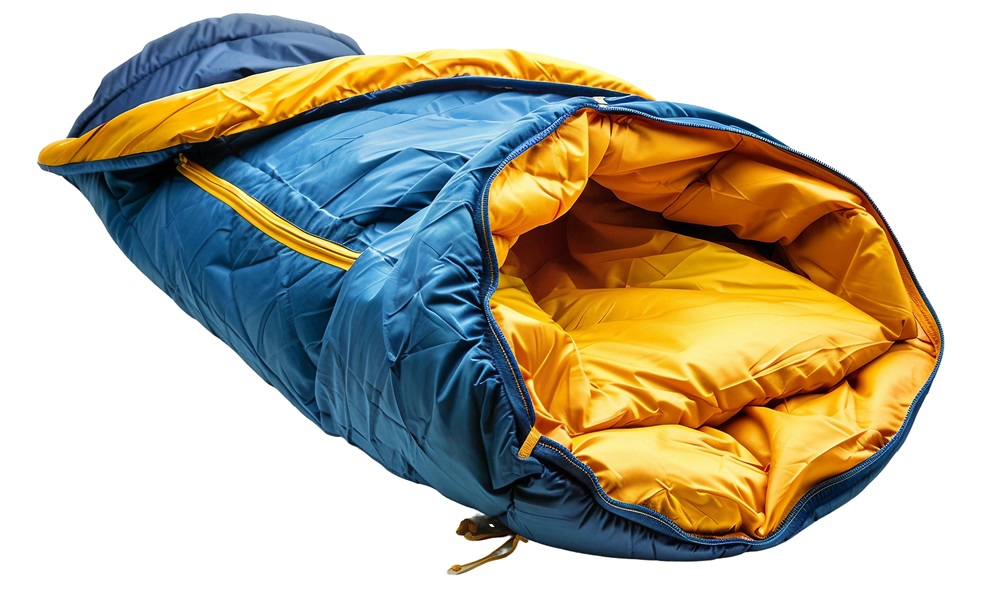Ever woken up freezing despite being in a supposedly warm sleeping bag? I discovered this problem during a winter camping trip where my marmot sleeping bag kept me toasty while my friend shivered all night in a similar-rated bag.
The difference? The draft collar construction—that seemingly minor feature that makes all the difference when temperatures plummet below freezing.
What Exactly Is a Draft Collar?
A draft collar is the insulated tube or barrier that wraps around your shoulders inside a sleeping bag. Think of it as a seal that blocks cold air from sneaking in and warm air from escaping through the opening of your bag.
This simple feature can make the difference between shivering all night and sleeping comfortably when temperatures drop. But not all draft collars are created equal, and their construction significantly impacts how well they work.
The Science Behind Heat Loss in Cold Environments
Your body loses heat in four main ways: conduction (direct contact), convection (air movement), radiation (heat waves), and evaporation (sweat). In sub-freezing environments, convection becomes your biggest enemy—warm air escaping and cold air entering your sleeping space.
Studies show that up to 43% of heat loss in a sleeping bag occurs around the neck and shoulder area. This happens because warm air naturally rises and tries to escape through the top of your bag.
How Draft Collar Design Affects Temperature Ratings
The effectiveness of a draft collar can actually change the true temperature rating of your sleeping bag by up to 15°F. Here’s what research shows about different construction methods:
| Draft Collar Type | Potential Heat Retention | Average Temperature Rating Impact |
| Basic Unfilled Collar | Minimal | +0-3°F improvement |
| Single Chamber Filled | Good | +5-10°F improvement |
| Dual Chamber Filled | Excellent | +10-15°F improvement |
| Anatomically Shaped | Superior | +10-15°F with better comfort |
Data based on controlled testing by outdoor gear research laboratories
Key Elements of Effective Draft Collar Construction
Material Matters
The outer fabric of the draft collar needs to be breathable yet windproof. Many high-quality bags use 10-15 denier ripstop nylon with a DWR (Durable Water Repellent) coating. This prevents moisture from your breath from entering the insulation.
The insulation itself needs to maintain loft even when compressed. Down-filled collars provide excellent insulation but must be kept dry, while synthetic fills like PrimaLoft maintain better performance when damp.
Shape and Ergonomics
The best draft collars curve anatomically around your neck rather than just forming a straight tube. This custom shape creates a better seal while allowing you to move comfortably during sleep.
Think about how a well-fitted scarf feels compared to simply wrapping a straight piece of fabric around your neck—the same principle applies here.
Closure Systems
How the draft collar tightens makes a huge difference in sub-freezing conditions. Separate drawcords for the hood and collar allow you to create a small breathing hole while keeping the collar snug.
When you’re in -20°F weather, fumbling with complex closure systems becomes nearly impossible with cold fingers. Simple, glove-friendly cordlocks that can be operated by feel are essential features that experienced winter campers look for.
Common Draft Collar Problems and Solutions
Problem: The Gap
Many sleeping bags have a gap between where the draft collar ends and the hood begins. This creates a cold spot that lets warm air escape.
Solution: Look for bags with overlapping collar and hood construction or add your own solution by wearing a neck gaiter to fill the gap.

Problem: Compression
When you turn in your sleep, many draft collars compress and lose their insulating properties.
Solution: Dual-chamber collars maintain loft on at least one side regardless of sleeping position. These use internal baffles to keep insulation in place.
Testing Your Draft Collar Before You Need It
Before heading into sub-freezing environments, test your sleeping bag’s draft collar at home:
- Get inside your bag in a cool room
- Tighten the draft collar as you would in cold conditions
- Have someone run their hand around the collar area to feel for air leaks
- Try turning from side to side to see if gaps form
This simple test could save you from a miserable night in the wilderness.
Beyond the Sleeping Bag: Creating a Complete System
Even the best draft collar can’t work alone. Your sleeping pad’s R-value (insulation rating) matters just as much as your bag in sub-freezing conditions.
Remember that a marmot sleeping bag or any quality bag works as part of a system. For every 10°F below freezing, consider adding 1 to your sleeping pad’s R-value. Most winter campers need an R-value of at least 5 for comfort on snow.
Final Thoughts: Investment in Safety and Comfort
When choosing a sleeping bag for extreme cold, remember that the draft collar isn’t just about comfort—it’s about safety.
Hypothermia can begin when your core temperature drops just a few degrees, and in remote winter environments, this becomes dangerous quickly.


